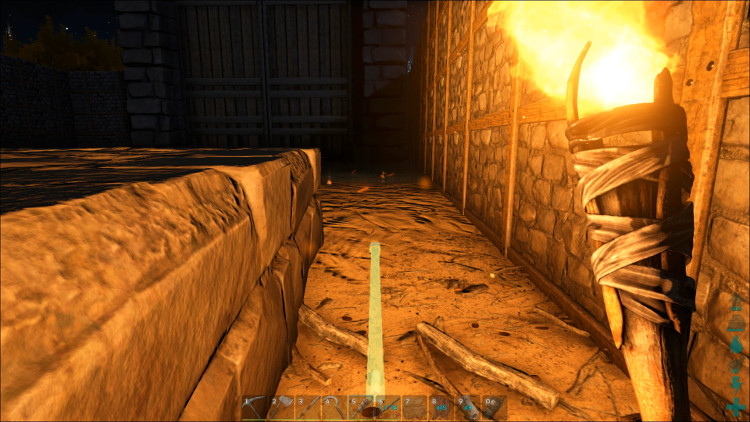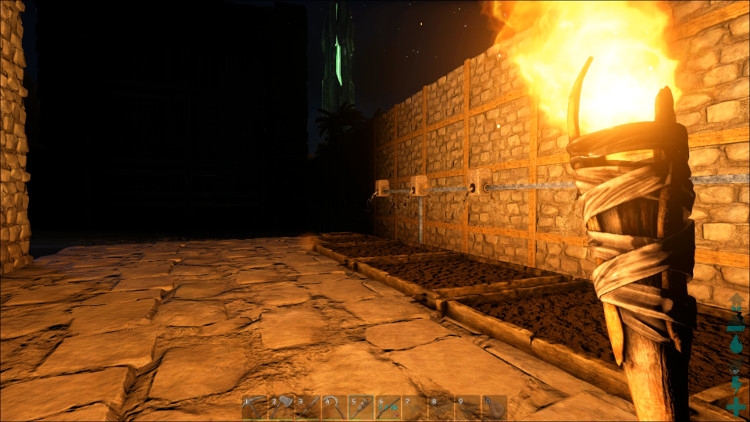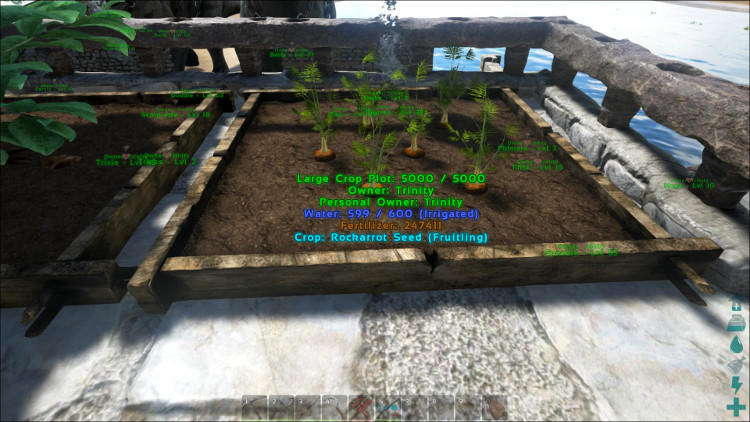Farming
Ark: Survival Evolved
Farming is a very good way to keep yourself supplied with food in Ark: Survival Evolved. It is also the only way to get some of the ingredients for the more advanced recipes used by the cooking pot. This guide will show you how to get set up with a basic farm and how to upgrade and expand it, ensuring you have the fruit and vegtables for the Rockwell Recipes you'll acquire.

A Basic Start - Water Intake, Pipes, & A Crop Plot
The minimum setup for successful farming includes a water intake pipe, a crop plot, and a tap. You'll also want a few different segments of pipe to connect it all. Keep in mind that at this time it is a real pain to try and build your piping along the ground, and as it can be nearly impossible to find the farming structures on the ground if there is any grass, you'll want to build on foundations.
The water intake pipe is the first thing you'll want to install to make sure that you've got a fresh supply of water. There is also the option of a water reservoir, however, these vary in expense and in effectiveness. They are of the most value if you are building far from a source of water.
Before you install too much pipe, you'll want to install your crop plots. This way you'll be able to see if they are getting irrigated once you install the taps. It may take a few minutes for them to show as irrigated. Also note that if you are using the resivoir system you'll probably find that your resivoirs run out very quickly when you are first installing your crop plots.


Taps & Basic Fertilizing
Once you have your crop plots installed you can start installing the taps above them, along with additional segments of pipe. Make sure all of your plots are Irrigated. This can take a few moments to update, so be patient.
While you may have water, nothing is going to grow unless you have fertilizer. At first you can simply put Dino and people droppings directly into the crop plot inventory. This is only so good, however, and you will want to upgrade to real fertilizer as soon as you can. Without it, it's almost a waste to build the farming system in the first place. Droppings in the crop plots do not last long. A crop plot that runs out of fertilizer or water will have the plant in it die rather quickly.
As soon as you have both irrigation and some fertilizer in your crop plots, you can put a Seed into each one. You don't need to put more than one. I'd also recommend filling each crop plot half full of fertilizer. Crops start to go wrong the moment they run out of water or fertilizer. The advanced crops, such as Rockarrot, Savroot, Longrass, and Citronal require at least a medium sized crop plot. The standard crops include Narcoberries, Stimberries, Amarberries, Azulberries, Mejoberries, and Tintoberries. These basic crops can be grown in a small crop plot. Keep in mind you can always use a larger crop plot than is required.


The Compost Bin & Water Reservoir
Two additional structures that can help are the Compost Bin and the Water Reservoir. The Compost Bin is nearly a requirement for good farming and the Water Reservoir is nearly as critical if you are not near a source of water.
If you build the Compost Bin and put in droppings and thatch it will slowly turn to bags of fertilizer. At this time it appears as though a few droppings plus 50 thatch is the recipe. Then it's a long wait. I'd suggest 4 Compost Bins with 200 Thatch in each one. Then stuff them full of droppings.
As for the Water Reservoir, it can get you water in areas away from natural water sources. It can be filled by rain, and hooks up to the pipes and taps to provide both irrigation and drinking water. Keep in mind that you can't do anything with it directly. It must be placed on a pipe, and the pipe must hook up to a tap. The basic reservoir only holds a small amount of water, while the more expensive higher level ones hold more water.
Keep in mind that you'll want at least 4 water resivoirs if you are completely reliant on them. You should also wait until your resivoirs and crop plots are fully filled with water before you plant seeds.


Growing Plant Species X
Plant Species X is a special plant and once fully grown does not require water but still requires fertilizer. It must also be grown in a large crop plot. The basic farming information above should get you setup well enough. For details on Plant Species X including where to find the seeds and its growth cycle, please check this page:
Plant Species X - Finding Seeds, Growing, & Maintaining

